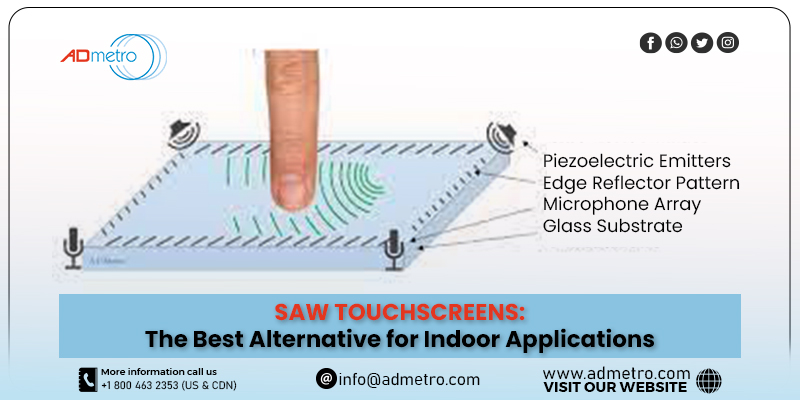Over the years, the touchscreen market has evolved with many innovative options, and surface acoustic wave (SAW) touchscreens are one of them. They have emerged as an excellent alternative for touch applications, especially indoor ones. Manufacturers often rely on this touch technology for applications like ATMs, public information kiosks, amusement parks, computer-based training and other high-traffic indoor environments.
Although SAW touchscreens possess several limitations, with some factors, they are ahead of capacitive and resistive touchscreens. A SAW touchscreen sensor comprises a sensor substrate that has a piezoelectric emitter affixed to its perimeter along with 2 or 3 receivers. Also, there are reflection ridges running along the perimeter of the sensor edges used to bounce ultrasonic sound back and forth across the surface of the sensor face.
How SAW Touchscreens Work
SAW touchscreens utilize ultrasonic sound waves for touch detection. For touch detection, the piezoelectric transducer sends out bursts of ultrasonic sound reflected by the perimeter ridges back and forth across the entire face of the sensor. Because the speed of sound is somewhat constant, it is identified when the originated burst of sound along with all the reflected bursts from the perimeter ridges reach each receiver. When a finger or other sound-absorbing stylus touches the sensor surface, some of that originated or reflected sound gets absorbed and missing when the controller expects to hear them arrive at the receivers. Those missing incidents allow the controller interface to determine the touch point.
Advantages & Disadvantages of SAW Touchscreens
SAW touchscreens are advantageous in many ways:
- they offer great optical clarity and higher transmission of light;
- the all-glass construction with no coatings to wear out contributes to the durability of the SAW touchscreen sensors;
- they are highly sensitive and respond quickly to touch.
However, SAW touchscreens also have some limitations:
- scratches in the substrate glass can cause dead spots on the sensor;
- they are vulnerable to surface contaminants and water;
- they require periodic tuning.
- They cannot be sealed around the perimeter for water and dirt ingress.
Features of SAW Touch Screens
- SAW touchscreens consist of a glass layer that makes them good at light transmission, and thus they offer excellent visibility.
- The glass surface is durable and resistant to scratches, thereby increasing the robustness of SAW touchscreens.
- They are not affected by external electric noise.
- They take input through a finger, gloved hand, or soft-tip stylus but anything with a hard tip, like a pen will not work.
- SAW touchscreens are not preferred for outdoor environments as they can be affected by a large amount of dirt, dust, water droplets etc.
Conclusion:
SAW touchscreens offer practical, simple-to-integrate, and cost-effective solutions. This technology is considered an excellent alternative for indoor applications requiring image clarity and sensor durability and are popular with gamming applications. And when you are looking for a more reliable solution in SAW technology, you can go with A D Metro, a manufacturer and supplier of innovative touchscreen solutions. They provide a complete line of Surface Acoustic Wave (SAW) touchscreen kits bundled with a controller and USB or RS232 interface.







